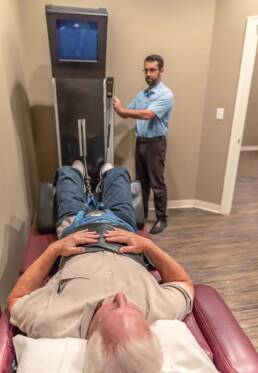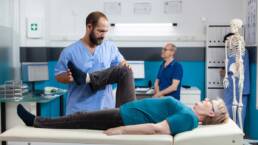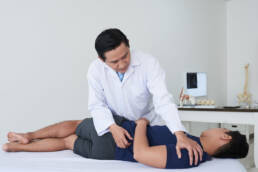Car accidents can be jarring and traumatic experiences, leaving victims with a range of injuries, including neck and back pain. Freedom Chiropractic, your trusted chiropractor in Conroe, TX, understands the challenges you face in the aftermath of a collision. We’re here to help you regain your health and well-being by providing effective chiropractic care. In this blog, we’ll explore nine chiropractic techniques that can significantly alleviate neck and back pain following a car accident.
Spinal Adjustment: Restoring Alignment for Pain Relief
Spinal adjustment, often referred to as spinal manipulation, is a cornerstone of chiropractic care. This technique focuses on realigning misaligned vertebrae in the spine to restore their proper positioning. It is highly effective in providing relief for neck and back pain, particularly after a car accident. Here’s a more in-depth look at how spinal adjustment works:
- Evaluation: Before any adjustments are made, your chiropractor will conduct a thorough evaluation of your spine, assessing its alignment, mobility, and any areas of concern. X-rays or other diagnostic tests may be used to pinpoint specific misalignments.
- Patient Preparation: You will be asked to lie down on a chiropractic table in a comfortable position. Your chiropractor will make sure you are relaxed and at ease to ensure the most effective adjustment.
- The Adjustment: Using their hands or specialized tools, your chiropractor will apply controlled, swift pressure to the targeted areas of the spine. This is typically a painless procedure, and many patients experience immediate relief as the vertebrae are brought back into alignment.
- Release of Endorphins: Spinal adjustments can stimulate the release of endorphins, your body’s natural painkillers. This provides not only immediate pain relief but also a sense of well-being and relaxation.
- Restoration of Function: Restoring proper spinal alignment improves the function of your nervous system, which is vital for overall health and well-being. It also supports the body’s natural ability to heal itself.
- Holistic Approach: Chiropractors take a holistic approach to healthcare, recognizing that the spine’s alignment can affect various aspects of your health, from pain relief to better sleep, improved mobility, and overall vitality.
Soft Tissue Massage: Easing Muscle Tension and Promoting Healing
Soft tissue massage is another essential technique employed by chiropractors to help alleviate neck and back pain following a car accident. It focuses on the muscles and connective tissues surrounding the spine, which can become tense and inflamed due to trauma. Here’s a closer look at how soft tissue massage can make a significant difference:
- Improved Blood Flow: Soft tissue massage helps to enhance blood circulation to the affected areas. This increased blood flow carries essential nutrients and oxygen to the injured tissues, aiding in the healing process.
- Muscle Relaxation: The manual manipulation of muscle tissue during a massage helps relax tight and tense muscles. This relaxation can alleviate pain, reduce muscle spasms, and improve your range of motion.
- Reduction of Scar Tissue: After an injury, your body may produce scar tissue. Soft tissue massage can break down these adhesions, making it easier for the muscle to function correctly and reducing pain.
- Stress Reduction: Beyond the physical benefits, soft tissue massage can also help reduce stress and promote a sense of relaxation, which is crucial for the body’s overall healing process.
- Targeted Treatment: Chiropractors are highly skilled in identifying the precise areas of muscle tension and applying the appropriate techniques to address them effectively.
Both spinal adjustments and soft tissue massage are integral parts of chiropractic care, working together to provide comprehensive relief for neck and back pain after a car accident. These techniques are tailored to your specific needs and can help you regain your mobility and comfort, promoting a healthier, pain-free future. If you’re experiencing such pain, don’t hesitate to seek professional help from Freedom Chiropractic in Conroe, TX, for a personalized treatment plan.
Physical Therapy: Restoring Strength and Function
Physical therapy is a vital component of chiropractic care, particularly when dealing with neck and back pain resulting from a car accident. After an injury, it’s essential to regain strength, flexibility, and mobility in the affected areas. Here’s a more detailed exploration of how physical therapy works within the chiropractic context:
- Individualized Assessment: Your chiropractor will assess your specific condition and create a personalized physical therapy plan. This plan takes into account your injury, your current level of function, and your long-term goals for recovery.
- Range of Motion Exercises: Physical therapy often includes a range of motion exercises that aim to improve flexibility and mobility in your neck and back. These exercises help to counteract stiffness and ensure that you can move freely without pain.
- Strengthening Exercises: Weak or damaged muscles can exacerbate pain and hinder recovery. Physical therapy includes a variety of strengthening exercises to target the affected muscles and build their strength over time.
- Functional Rehabilitation: Your chiropractor will also work with you on functional rehabilitation exercises. These are movements and activities tailored to your daily life, ensuring that you can perform essential tasks without discomfort.
- Pain Management: Physical therapy often incorporates pain management strategies, such as heat or cold therapy and the use of therapeutic modalities like ultrasound or electrical stimulation to alleviate pain and inflammation.
- Patient Education: In addition to hands-on treatment, physical therapy involves educating patients about proper body mechanics, posture, and lifestyle changes that can promote long-term well-being and prevent future injuries.
Physical therapy plays a crucial role in your post-accident recovery journey. It complements chiropractic adjustments and other techniques by addressing the functional aspects of your pain and promoting holistic healing.
Myofascial Release: Targeting Connective Tissue Tension
Myofascial release is another technique used in chiropractic care, primarily focused on the fascia, a connective tissue that surrounds muscles and other structures in the body. This technique can be especially effective in addressing neck and back pain caused by muscle tension and imbalances. Here’s a more in-depth look at myofascial release:
- Identification of Trigger Points: Your chiropractor will identify areas of tension and trigger points within your myofascial system. These points often correspond to specific sources of pain and discomfort.
- Gentle Pressure Application: Myofascial release involves applying gentle, sustained pressure to these trigger points. This pressure helps to release tension and improve the elasticity of the fascia.
- Improved Circulation: As tension in the fascia is released, blood flow to the affected areas improves. This increased circulation delivers essential nutrients and oxygen, aiding in the healing process.
- Pain Reduction: Myofascial release can significantly reduce pain associated with muscle tension, stiffness, and adhesions in the fascia. Many patients experience immediate relief during and after the treatment.
- Enhanced Range of Motion: By releasing tight fascia and tension in the muscles, myofascial release can lead to improved flexibility and range of motion, allowing you to move more freely without discomfort.
Myofascial release is a gentle yet highly effective technique that complements other chiropractic treatments. It helps address muscle-related issues, supporting the overall goal of pain relief and healing after a car accident.
Incorporating physical therapy and myofascial release into your chiropractic care plan at Freedom Chiropractic in Conroe, TX, can provide a well-rounded approach to addressing neck and back pain, promoting your overall recovery and well-being.
Ultrasound Therapy: A Healing Wave of Sound
Ultrasound therapy is a widely used chiropractic technique that utilizes high-frequency sound waves to promote healing and reduce pain in injured or painful areas, including the neck and back. Here’s a closer look at how ultrasound therapy works and its benefits:
- Introduction of Ultrasound Waves: During an ultrasound therapy session, your chiropractor will apply a gel to the skin in the targeted area. A handheld device, called an ultrasound transducer, is then moved gently over the gel-covered skin.
- Sound Wave Transmission: The transducer emits high-frequency sound waves, which penetrate deep into the body’s tissues. These sound waves are beyond the range of human hearing, and they create a warming effect deep within the body.
- Thermal Effects: The sound waves produce a gentle heat, which increases blood flow to the treated area. Improved circulation is essential for delivering oxygen and nutrients to injured tissues, facilitating the healing process.
- Relaxation of Muscles: Ultrasound therapy helps to relax muscles and reduce stiffness, which can be particularly beneficial in the neck and back, where muscle tension can exacerbate pain.
- Reduction of Inflammation: The gentle heat generated by ultrasound therapy can help reduce inflammation in the injured area, relieving pain and promoting the body’s natural healing response.
- Pain Management: The warming effect of ultrasound therapy also has a pain-relieving quality, making it especially effective in alleviating discomfort in the neck and back after a car accident.
Ultrasound therapy is a non-invasive and painless technique that offers numerous benefits. It complements other chiropractic treatments, providing a holistic approach to addressing neck and back pain.
Electrical Stimulation: Managing Pain with Controlled Currents
Electrical stimulation, often referred to as e-stim or TENS (Transcutaneous Electrical Nerve Stimulation), is a chiropractic technique that uses low-voltage electrical currents to manage pain, promote muscle relaxation, and reduce muscle spasms. Here’s a more detailed exploration of how electrical stimulation works and its applications:
- Electrode Placement: Your chiropractor will attach adhesive electrodes to the skin in the area of concern. These electrodes are connected to a device that controls the electrical current.
- Controlled Currents: The electrical stimulation device emits controlled, low-voltage electrical currents through the electrodes. These currents are carefully calibrated to ensure comfort and safety.
- Pain Management: The electrical currents interfere with pain signals sent to the brain, effectively reducing the perception of pain in the treated area. This can be particularly beneficial for individuals experiencing neck and back pain after a car accident.
- Muscle Relaxation: Electrical stimulation can relax muscle spasms and tension in the affected area, allowing for greater comfort and improved mobility.
- Enhanced Blood Flow: The stimulation also promotes increased blood flow to the treated area, which aids in the delivery of essential nutrients and oxygen to the injured tissues, supporting the healing process.
- Targeted Treatment: Electrical stimulation can be adjusted to target specific areas and types of pain, making it a versatile technique in chiropractic care.
Electrical stimulation is a safe, non-invasive, and drug-free way to manage pain and facilitate the healing process, especially in the context of neck and back pain following a car accident. It is often used in combination with other chiropractic techniques to provide comprehensive care and relief.
Heat and Cold Therapy: Temperature-Based Relief
Heat and cold therapy, also known as thermotherapy and cryotherapy, are essential techniques in chiropractic care for addressing pain and inflammation, particularly in the neck and back. Each therapy offers unique benefits and can be used depending on the specific needs of the patient:
Heat Therapy
- Relaxation of Muscles: The application of heat to the affected area helps to relax tight muscles, reducing muscle spasms and pain.
- Improved Blood Flow: Heat therapy promotes increased blood circulation, which assists in the delivery of essential nutrients and oxygen to the injured tissues, aiding in the healing process.
- Pain Relief: The warmth generated by heat therapy can help alleviate pain by increasing the threshold for pain signals and promoting muscle relaxation.
- Increased Flexibility: Applying heat before stretching or exercise can improve flexibility and range of motion, which is especially useful in rehabilitation.
Cold Therapy
- Inflammation Reduction: Cold therapy is excellent for reducing inflammation and swelling in the injured area, making it highly effective in the immediate aftermath of a car accident.
- Numbing Effect: Cold therapy can temporarily numb the treated area, providing immediate pain relief and reducing muscle spasms.
- Preventing Further Damage: Cold therapy can help prevent further damage to injured tissues by restricting blood flow, making it particularly useful when used in the early stages of an injury.
Both heat and cold therapy can be used in combination with other chiropractic techniques to enhance pain relief and facilitate the healing process. Chiropractors will assess your condition and recommend the most appropriate therapy for your specific situation.
Lifestyle and Ergonomic Advice: Long-Term Wellness Strategies
Chiropractic care extends beyond immediate pain relief to promote long-term well-being, and this includes offering lifestyle and ergonomic advice. Your chiropractor may provide guidance on making healthier choices and creating a more comfortable and supportive environment for your neck and back:
- Posture Correction: Chiropractors often address posture-related issues, providing advice and exercises to help you maintain proper alignment and reduce the risk of developing chronic pain.
- Ergonomic Changes: For individuals who spend a significant amount of time at a desk or performing repetitive tasks, ergonomic advice is crucial. Your chiropractor may recommend changes in your workspace, such as adjusting your chair, keyboard, or monitor height to reduce strain on your neck and back.
- Exercise and Nutrition: Chiropractors may suggest appropriate exercises to strengthen your core and improve flexibility. They can also provide nutritional advice to support your body’s healing and overall health.
- Stress Management: Chronic stress can contribute to neck and back pain. Chiropractors may offer stress management techniques such as relaxation exercises, meditation, or breathing exercises to help reduce tension.
- Preventive Measures: Your chiropractor can educate you on how to prevent future injuries, such as proper lifting techniques and warm-up exercises before physical activity.
Lifestyle and ergonomic advice are integral parts of chiropractic care as they empower patients to take control of their health and minimize the risk of recurring issues. These recommendations are tailored to the individual’s needs and circumstances, ensuring that patients can maintain a pain-free, healthy, and active life.
Posture Correction: The Key to Long-Term Pain Relief
Posture correction is a fundamental aspect of chiropractic care, especially when addressing neck and back pain. Poor posture, whether caused by habit, injury, or muscle weakness, can exacerbate pain and contribute to the development of chronic issues. Here’s a more detailed look at how posture correction is essential in chiropractic care:
- Assessment: The first step in posture correction is a thorough assessment by your chiropractor. This involves evaluating your current posture, identifying areas of misalignment, muscle imbalances, and poor habits that may be contributing to your pain.
- Customized Exercises: Based on the assessment, your chiropractor will develop a customized plan that may include specific exercises and stretches to address your posture issues. These exercises are designed to strengthen weak muscles and stretch tight ones, helping you regain a more natural and balanced posture.
- Ergonomic Adjustments: Your chiropractor may also provide recommendations for making ergonomic adjustments to your daily life, such as how you sit at your desk, how you carry your bag, and even how you sleep. These changes can reduce the strain on your spine and improve your posture over time.
- Postural Awareness: Part of posture correction involves educating patients about the importance of maintaining good posture in their daily activities. Developing postural awareness can help you catch yourself in positions that may worsen your pain.
- Long-Term Benefits: Correcting your posture not only alleviates current pain but also prevents future issues. It’s a proactive approach to spinal health, enhancing your overall quality of life and preventing recurring problems.
By focusing on posture correction, chiropractors empower patients to take an active role in their health and well-being. Over time, these adjustments can lead to significant improvements in pain relief and overall mobility, allowing individuals to live more comfortable and pain-free lives.
Conclusion
Neck and back pain resulting from a car accident can be debilitating and significantly impact your daily life. However, chiropractic care, offered by dedicated professionals like Freedom Chiropractic in Conroe, TX, provides a holistic approach to addressing these issues. The chiropractic techniques discussed in this blog offer effective and personalized solutions for pain relief and long-term healing.
Spinal adjustments, soft tissue massage, physical therapy, myofascial release, ultrasound therapy, electrical stimulation, heat and cold therapy, and lifestyle and ergonomic advice all play integral roles in your recovery journey. These techniques work together to alleviate pain, reduce inflammation, and restore your mobility, helping you regain your freedom from pain.
Chiropractic care is not just about symptom management; it’s about empowering you to lead a healthier, more comfortable life. Beyond immediate relief, chiropractors offer guidance on posture correction, ergonomic adjustments, and lifestyle changes that can prevent future issues and promote long-term well-being.
If you’ve been in a car accident and are experiencing neck or back pain, don’t hesitate to seek professional help from Freedom Chiropractic. Your health and well-being are their top priorities, and they are committed to guiding you on your journey to recovery. By providing a comprehensive and personalized approach to care, they can help you get back to living your life to the fullest, free from pain and discomfort.

Ready for a complimentary consultation? Get in touch today!
Much like an engineer, we focus on setting up your body to do the activities that you want to do most. An engineer would make sure a bridge could accommodate Houston traffic, and we will make sure your body can accommodate your favorite sport, family activity, or your next adventure.
Like this article? Spread the word!
Related Posts
April 23, 2024
Using a Chiropractor After a Car Accident
After a car accident, seeking chiropractic care is essential. Learn how Freedom…
December 27, 2023
Recovering from Auto Accidents: Why Seeking a Chiropractic Evaluation is Crucial
Discover the importance of immediate chiropractic evaluation after an auto accident in…
November 29, 2023
Relief Roadmap: Managing Post-Accident Headaches with Chiropractic Care in Conroe, TX
Experience relief from post-accident headaches and migraines at Freedom Chiropractic in…




